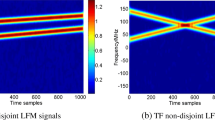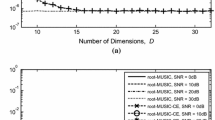Abstract
Frequency hopping spread spectrum (FHSS) is a technology for combating narrow band interference. Two parameters required for estimation in FHSS are transition time and hopping frequency. In this paper, blind subspace-based schemes with a maximum likelihood (ML) criterion for estimating frequency and transition time without using reference signals are proposed. The selection of the related parameters is discussed. Subspace-based algorithms are applied with the help of the proposed block selection scheme. The performance is improved with a block selection algorithm to overcome the unbalanced processing block problems in various algorithms. The proposed method significantly reduces computational complexity compared with a greedy search ML-based algorithm. The performance is shown to outperform an existing iterative ML-based algorithm with a comparable complexity.





Similar content being viewed by others
References
Zhao, H., & Wang, Q. (1998). On frequency hop synchronization in multipath Rayleigh fading. IEEE Transactions on Vehicular Technology, 47(3), 1049–1065.
Min, J., & Samuel, H. (1996). Synchronization techniques for a frequency hopped wireless transceiver. In Proceedings of the IEEE vehicular technological conference, Atlanta, GA, USA (pp. 183–187).
Min, J. S., & Samueli, H. (2000). Analysis and design of a frequency-hopped spread-spectrum transceiver for wireless personal communications. IEEE Transactions on Vehicular Technology, 49, 1719–1731.
Siu, Y. M., Chan, W. S., & Leung, S. W. (2001). A SFH spread spectrum synchronization algorithm for data broadcasting. IEEE Trans. on Broadcasting, 47, 71–75.
Yonghong, Q., & Zhongmin, G. (1998). Research on downlink synchronization of a frequency-hopping satellite communication system. In Proceedings of the IEEE communication technology conference, Beijing, China (pp. s17-05-1–s17-05-4).
Weidong, L., Jing, W., & Yan, Y. (1998). Synchronization design of frequency-hopping communication system. In Proceedings of the IEEE communication technology conference, Beijing, China (Vol. 1, pp. 115–119).
Liang, J., Gao, L., & Yang, S. (2005). Frequency estimation and synchronization of frequency hopping signals based on reversible jump MCMC. In Proceedings of the international symposium on intelligent signal processing and communication systems, Hong Kong (pp. 589–592).
Liu, X., Li, J., & Ma, X. (2007). An EM algorithm for blind hop timing estimation of multiple FH signals using an array system with bandwidth mismatch. IEEE Transactions on Vehicular Technology, 56(5), 2545–2554.
Fan, H., Guo, Y., & Feng, X. (2008). Blind parameter estimation of frequency hopping signals based on matching pursuit. In Proceedings of the 4th IEEE international conference on wireless communications, networking and mobile computing, Dalian, China (pp. 1–50).
Mallat, S. G., & Zhang, Z. (1993). Matching pursuit with time-frequency dictionaries. IEEE Transactions on Signal Processing, 41(12), 3397–3415.
Liu, X., Sidiropoulos, N. D., & Swami, A. (2005). Joint hop timing and frequency estimation for collision resolution in FH networks. IEEE Transactions on Wireless Communications, 4(6), 3063–3074.
Valyrakis, A., Tsakonas, E. E., Sidiropoulos, N. D., & Swami, A. (2009). Stochastic modeling and particle filtering algorithms for tracking a frequency-hopped signal. IEEE Transactions on Signal Processing, 57(8), 3108–3118.
Ko, C. C., Zhi, W., & Chin, F. (2005). ML-based frequency estimation and synchronization of frequency hopping signals. IEEE Transactions on Signal Processing, 53(2), 403–410.
Schmidt, R. O. (1986). Multiple emitter location and signal parameter estimation. IEEE Transactions on Antenna and Propagation, AP-34(3), 276–280.
Roy, R., & Kailath, T. (1989). ESPRIT-estimation of signal parameters via rotational invariance techniques. IEEE Transactions on Acoustics, Speech, and Signal Processing, 37(7), 984–994.
Acknowledgments
The authors would like to thank the Ministry of Science and Technology of the Republic of China, Taiwan, for financially supporting this research under Contract no. MOST 104-2221-E-008-044.
Author information
Authors and Affiliations
Corresponding author
Appendices
Appendix 1: Derivation of Multiroots in ( 10 ) and ( 11 )
In this appendix, we demonstrate the multiroot problem of (10) and (11) by the following development. As these two equations are similar, (10) is used in the derivation. The same development can be applied to (11).
\(\text{Im} ({\mathbf{X}}_{1}^{H} {\mathbf{D}}_{1} {\mathbf{S}}_{1} {\mathbf{S}}_{1}^{H} {\mathbf{X}}_{1} )\) is expanded. After some manipulations, we have
where
Consider the situation without noise. By substituting \(m = 1, 2, \ldots ,K - 1\) into (28), we obtain
By substituting (28) into (26), we obtain
In (30), there are (K − 1) \(\sin ( \cdot )\) terms. It can be viewed as multi-order harmonic sine waves \(m(\bar{\omega }_{1} - \bar{\omega })\), \(m = 2, \ldots , K - 1\) and thus there are multiple roots (up to K − 1 roots).
Based on the above result, it leads that the iteration algorithm (41) in [13] has a problem to converge to the correct estimate. Since it has the multi-root problem, \(\hat{\bar{\omega }}_{1} (K)\) in (41) may or may not converge to the correct region (either infected by the initial value of \(\hat{\bar{\omega }}_{1} (1)\) or by the noise). Figure 6 shows the example of SNR = 4 dB by using the iterative ML algorithm of [13]. The scatter plot of the estimation errors is displayed in 10,000 trial runs of f 1 = 18,000 Hz, f 2 = 29,000 Hz, M = 128, and K = 64. Observed from Fig. 6, the majority of the estimation errors are located around the region of −1567, 0, and 1567 Hz (which are relative to the zero points at 16,433, 18,000, and 19,567 Hz). Due to the above-mentioned problem, the estimation errors disperse in the frequency band.
Appendix 2: Derivation of \(\hat{\omega }_{1} = \mathop {\arg }\limits_{{\omega_{1} }} \left\{ {\hbox{max} \left( {\left\| {{\hat{\mathbf{s}}}_{1}^{H} (\omega_{1} ){\mathbf{x}}_{1} } \right\|^{2} }/K \right)} \right\}\)
By expanding (8), we have \(\varphi_{1} (a_{1} ,\omega_{1} ,K) = \left\| {{\mathbf{x}}_{1} - a_{1} {\mathbf{s}}_{1} } \right\|^{2} = \left\| {x_{1} } \right\|^{2} - a_{1}^{H} {\mathbf{s}}_{1}^{H} {\mathbf{x}}_{1} - a_{1} {\mathbf{x}}_{1}^{H} {\mathbf{s}}_{1} + \left\| {a_{1} {\mathbf{s}}_{1} } \right\|^{2}\).
To minimize φ 1(a 1, ω 1, K), by setting ∂φ 1/∂a 1 = 0, we have
Putting \(\hat{a}_{1} = \frac{1}{K}{\text{s}}_{1}^{H} {\mathbf{x}}_{1}\) in φ 1(a 1, ω 1, K), we have
With \(\hat{a}_{1}\) and \(\hat{\omega }_{1} ,\) the objective function becomes
For a given K, the minimization of φ 1(a 1, ω 1, K) is equivalent to finding a frequency ω 1 satisfying
Rights and permissions
About this article
Cite this article
Fu, KC., Chen, YF. Subspace-Based Algorithms for Blind ML Frequency and Transition Time Estimation in Frequency Hopping Systems. Wireless Pers Commun 89, 303–318 (2016). https://doi.org/10.1007/s11277-016-3364-z
Published:
Issue Date:
DOI: https://doi.org/10.1007/s11277-016-3364-z





